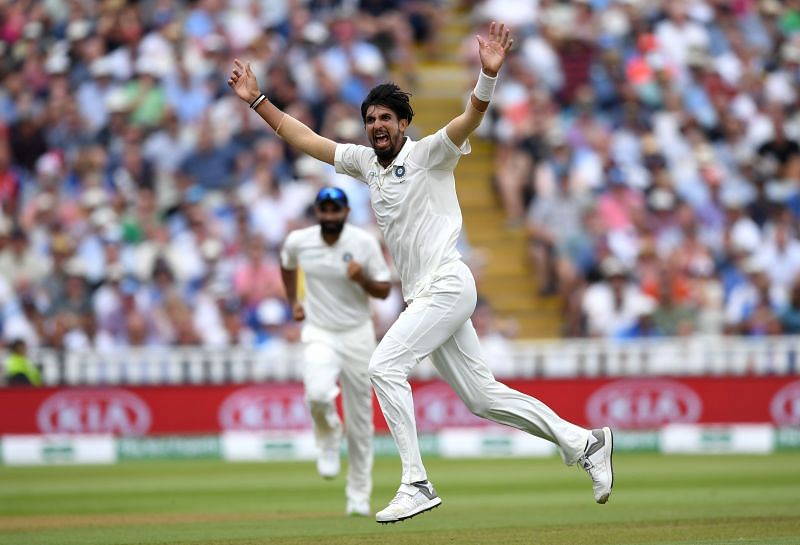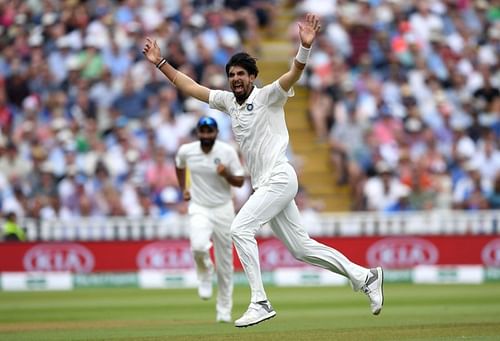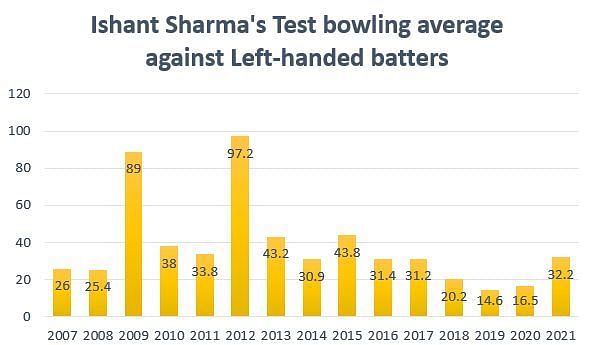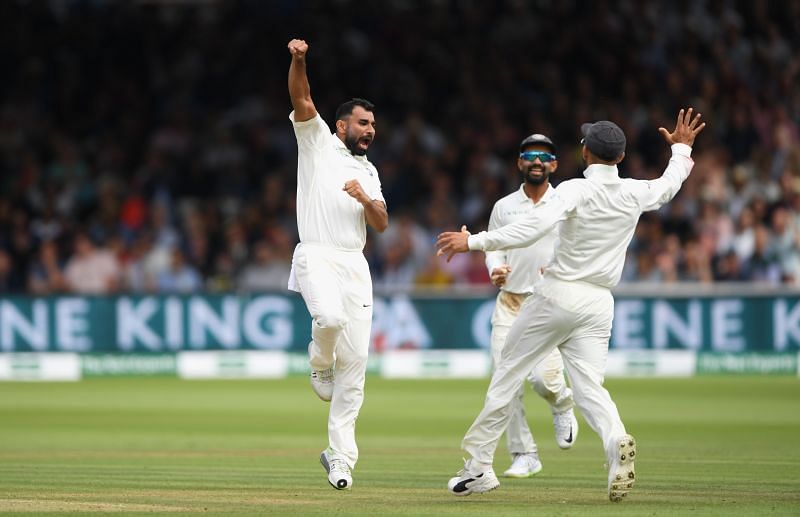
WTC Final: India must unleash Ishant Sharma and Mohammed Shami in tandem

On 15th June 2021, India released their 15-man squad for the upcoming World Test Championship final against New Zealand. As expected, all of India’s biggest gunslingers featured, with the glut of fast-bowlers, in particular, being a source of joy and elation.
Not only had India named five specialist fast bowlers, they had also selected five seamers capable of rattling any international cage. From a broader perspective, it hinted at the strength of India’s pace battery.
As far as the immediate future is concerned, it also highlights the enormity of the headache Ravi Shastri and Virat Kohli have, for each of Ishant Sharma, Jasprit Bumrah, Mohammed Shami, Mohammed Siraj and Umesh Yadav are top-quality alternatives.
While there exists a general consensus that Umesh Yadav might not get a gig, considering his lack of game time and the injuries he has suffered lately, the debate has been raging around the identity of India’s second and third pacers, with several weighing in on who should line up alongside Jasprit Bumrah.
From some quarters, there have been clamours for Mohammed Siraj, who has thoroughly impressed since the tour Down Under, to be included. Others, meanwhile, have opined that Ishant Sharma and Mohammed Shami are un-droppable and they, much like Bumrah, should be certainties to start against the Black Caps.
Thus, with only two sunsets remaining between India and the WTC Final, one can imagine the almighty quandary the Men In Blue find themselves in. To an extent, they might be quietly gleaming that they have the luxury of such a conundrum. Reality, though, might indicate that one wrong decision could lead to an unraveling of an entire Test cycle.
To place things into context, Mohammed Siraj, whenever he has played, has only strengthened an already burgeoning reputation. In Australia, when he was handed his Test cap at the Melbourne Cricket Ground, he seemed a complete greenhorn and one that had the unenviable task of filling Mohammed Shami’s boots.
As each game progressed, he showcased the maturity he has garnered on various India A tours – an experience that seems to have enriched his bowling. In fact, by the time the tour was done, he was spearheading India’s bowling attack Down Under.
Though he might’ve ideally wanted a gentler introduction to Test cricket, he seemed to relish every bit and even enjoyed the responsibility bestowed upon him.
Hence, it isn’t a surprise to see India contemplate including Siraj for the WTC Final. Not just because he is bristling with confidence, but also because he seems ready to handle the pressure associated with a major final.
However, at the other end of the spectrum stand Ishant Sharma and Mohammed Shami – bowlers who have been vital cogs in India’s ascent to the perch of Test cricket and of course, the WTC final.
From a romantic standpoint, one might even forgive India for wanting to give the aforementioned duo the chance to write themselves into cricketing folklore. However, there are enough aspects (on the cricketing front as well) to suggest that Ishant and Shami simply need to start against New Zealand.
India will have to tackle several left-handed batters in WTC Final
For starters, the Kiwis are expected to line up with quite a few left-handed batters. As things stand, Devon Conway is slated to open with Tom Latham, while Henry Nicholls, in all likelihood, will man the middle order.
Lower down, India might have to contend with Neil Wagner and possibly Ajaz Patel. Yet, three left-handed batters in the top six indicate that India might have to be well-equipped against them if they are to deflate the Black Caps.
At the start of his career, Ishant Sharma struggled against left-handed batters, for his stock delivery, which went away from those batters, never posed a threat. A reason for it was that he tended to bowl a lot shorter than what was desirable – something that allowed left-handers to leave the ball easily.
Now, though, he bowls a lot fuller, meaning that these batters are forced into poking and prodding at deliveries, exposing the outside edge in the process. As far as numbers are concerned, he averages 19.02 against left-handed batters since 2018, picking up 48 wickets across 41 matches.

Additionally, Ishant has developed a ball that comes into the left hander. While it isn’t a booming in-swinger akin to what someone like James Anderson or Bhuvneshwar Kumar can produce, it does just enough to target the pads.
Most tellingly, Ishant has, over the past few years, been very adept at bowling round the wicket to left-handed batters – something that might mirror what Stuart Broad did in the recently concluded series against New Zealand. It wouldn’t be a stretch to suggest that both pacers have unique similarities, considering their height and the way they set batters up.
In the aforementioned rubber, Devon Conway, who ended up as the Player of the Series, plundered runs for fun. However, the only time there seemed an iota of tentativeness around his batting was when he was confronting Stuart Broad. That the pacer dismissed him twice only highlights his struggles.
Even though Conway usually came through Broad’s opening spell unscathed, he never looked comfortable. While he was diligent in leaving deliveries outside off stump, he was a touch circumspect when balls, which were pitched on a back of a length, angled into him from round the wicket.

With Ishant’s natural length being congruent to what Broad was incessantly nibbling away at, it could help India contain Conway. Moreover, the back of a length deliveries only caused trouble because Broad’s height allowed him to generate extra bounce. And, with none of India’s other pacers capable of extracting that sort of bounce, Ishant’s selection should be a given.
Elsewhere, Tom Latham also perished LBW on two occasions to Stuart Broad. Both times, the latter set him up with an out-swinger before decking the ball back into the batter.
Henry Nicholls, although he didn’t seem too perturbed by Broad’s nagging lines and lengths, looked a little uncomfortable when balls were pitched fuller – something that could be exploited by Mohammed Shami. His career average against full deliveries hovers in the 30s, whereas the corresponding numbers against good length balls and short balls spirals up over 40.
Shami also has a tendency to seam the ball both ways from round the wicket – another facet that could cause a furrowed brow or two in the Kiwi ranks. In addition, he also has a decent record against BJ Watling (4 dismissals in 13 innings) and Tom Latham (3 dismissals in 11 innings). Ishant, on the other hand, has a stellar head-to-head against Ross Taylor, with the India stalwart accounting for him 4 times in 11 essays.
When talking about Shami specifically, he can be classified as a streak-y bowler – someone who can be nigh on unplayable when he gets into the groove. During such phases, the seamer can bowl at searing pace, while also getting the ball to deck around.
And, with the rest of the bowlers, namely Ishant, Ravichandran Ashwin and Ravindra Jadeja, capable of keeping things tight, Shami could be used for such short and sharp spells.

Furthermore, the English summer has been quite taxing so far, meaning that the overhead conditions haven’t usually aided swing bowling, especially with the clouds higher than normal. Even when there has been swing, as was the case on the opening couple of days at Edgbaston, it swung from the hand, meaning that the batters were largely able to adjust.
However, seam movement hasn’t been at a premium. Matt Henry, who is predominantly a seam bowler, optimally utilized the conditions as the Kiwis skittled England out cheaply in the latter’s second innings at Edgbaston. And, Shami, if anything, is more dexterous than Henry, even if both seem cut out from a similar cloth.
Ishant and Shami also have experience of international red-ball cricket in England. And while the initial reaction might be to throw weight behind Siraj’s exceptional displays with the India A side in England (15 wickets in 2 games at 17.73), one mustn’t forget that Ishant was India’s leading wicket-taker (second highest overall) on the 2018 tour to England.
Thus, there is enough evidence to illustrate that India might be better served in placing their faith in Ishant and Shami come the World Test Championship. That, though, isn’t an indictment on Mohammed Siraj’s qualities, who has, simply put, been sensational since the tour Down Under.
And while there might be a huge temptation for Virat Kohli to include his Royal Challengers Bangalore teammate, it might just be prudent to cast it aside, for the moment.
At present, there aren’t many better exponents of fast bowling than Ishant and Shami. And, for that very reason, they simply must feature in India’s biggest Test clash in the 21st century.
After all, they’re two of the primary reasons why India are here in the first place, isn’t it?